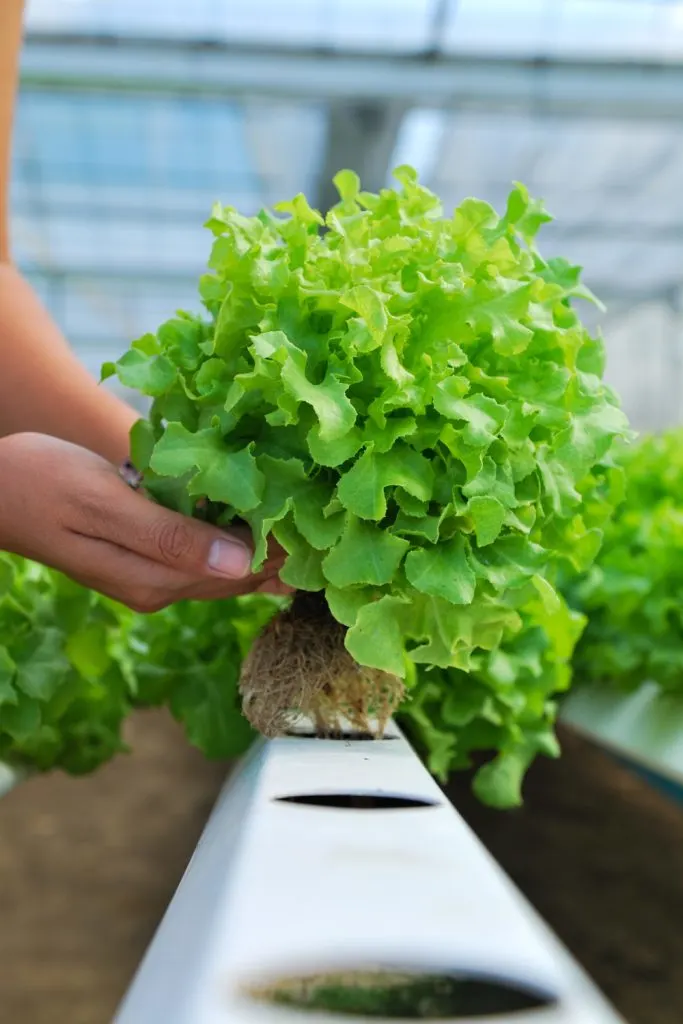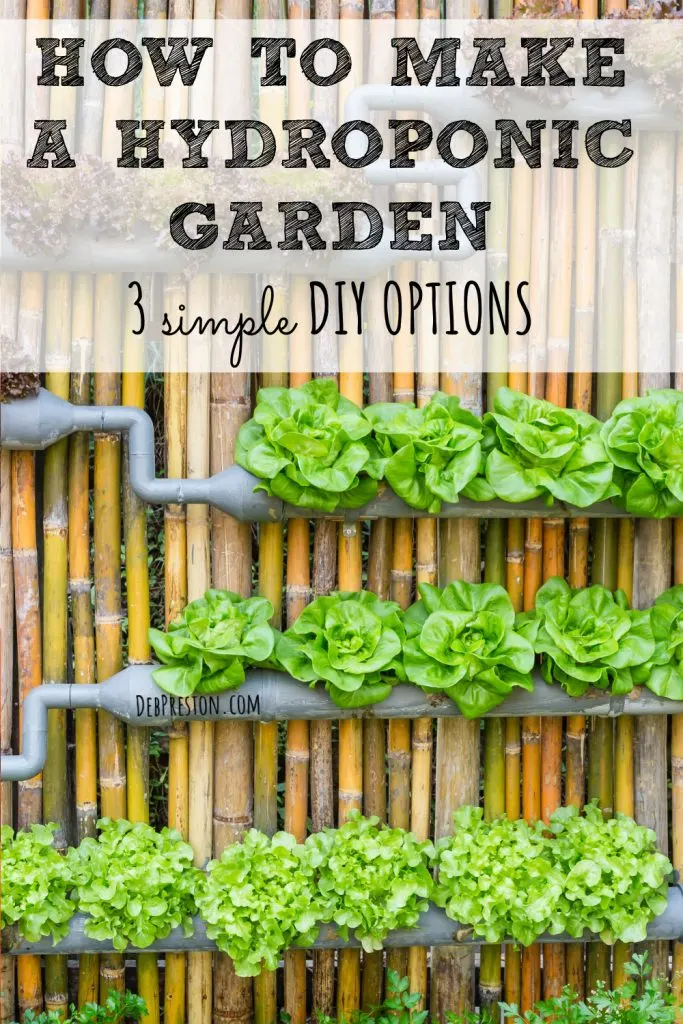I gave traditional gardening a solid try for five years. I built raised beds with high quality soil, planted veggies and fruits “zoned” for our area, fertilized religiously, watered, pulled weeds, all of it.
And while it was rewarding, it seemed like a whole lot of work for an underwhelming amount of produce. With the south
Texas sun and pests undermining my every effort, I wondered if it even made sense to garden. Were my cucumbers worth the time, effort, and money?
Then one Christmas, my husband surprised me with a hydroponic garden. No rocks in the soil, no weeds, no pests burrowing under my seedlings…hydroponic gardening was not only fun, but felt like a wise financial move.
I grew tomatoes and peppers and herbs and literally hundreds of heads of organic lettuce that first year, all from the comfort of my dining room, thanks to a grow light. And I’ve never looked back since!
Wondering how to make a hydroponic garden for yourself? I’m glad you asked!
Understanding Hydroponics
Hydroponic gardening is an efficient way of cultivating plants that uses less water than traditional soil farming. It’s a soil-less method where nutrients are delivered via a water-based solution.
Benefits of Hydroponic Gardening
- Efficiency: Your hydroponic garden will use up to 90% less water than soil-based gardens. This is because the system recirculates water, leading to significant savings.
- Space-Saving: Grow more in less space. Without the need for soil, you can stack hydroponic systems vertically or fit them in tighter spaces.
- Growth Rate: Plants often grow faster thanks to the direct delivery of nutrients to their roots.
Types of Hydroponic Systems
Hydroponic gardening comes in many different forms. But for any hydroponics system to be successful, it has to make a plan for both (1) oxygen exposure and (2) nutrient delivery.
- Deep Water Culture (DWC): With this method, your plants’ roots dangle in nutrient-rich water, receiving ample oxygen from an air pump. It’s straightforward and favored by beginners and experts alike.
- Nutrient Film Technique (NFT): In this method, a continuous flow of nutrient solution runs over the roots, which hang in the air, allowing for excellent oxygen exposure and nutrient uptake.
- Aeroponics: With this method, the roots of your plants hang in the air and are periodically misted with a nutrient solution, offering maximum oxygenation and minimal water usage. This method is often sold pre-packaged and ready to roll by companies like Lettuce Grow.
By choosing hydroponic gardening, you’re not just conserving water; you’re also setting yourself up for an efficient, high-yield garden. Whether you opt for Deep Water Culture or a more advanced Aeroponic system, you’re on your way to growing plants more sustainably!

Setting Up Your Hydroponic Garden
Ready to learn how to make a hydroponic garden?! First things first, you’ll want to pay close attention to location, plant selection, and equipment to get started.
Choosing the Right Location
Your hydroponic garden thrives with ample light and stable temperatures.
Look for an area that receives plenty of natural light, whether outside or indoors. If that’s not possible, or if you just prefer an indoor location like I did, consider setting up a grow light system to ensure your plants get the necessary light exposure.
(Here’s a video that will walk you through a simple – and cheap! – grow light setup!)
Ensure the space is free from drastic temperature changes, which could impact plant growth.
Selecting Plants for Your Garden
When building out your own hydroponic garden, start by choosing plants that are known to do well in a hydroponics system.
While leafy greens like lettuce, spinach, and Swiss chard will flourish, larger plants like watermelon would obviously be a pain. I’ve personally enjoyed growing cherry tomatoes, peppers, zucchini, cucumbers, sugar sprint peas, strawberries, ground cherries (So strange, so tasty!), herbs, and of course, loads of leafy greens.
If you’re interested in growing larger plants, make sure your hydroponics system can accommodate their root systems and height.
Gathering the Necessary Equipment
Your hydroponics system will require a few key components, depending on which hydroponic gardening method you’ll be using.
Deep Water Culture System
To build a Deep Water Culture system, or DWC system, you’ll need the following equipment:
- Reservoir: A large bucket or container to hold the nutrient solution. Common choices are 3 to 5-gallon buckets.
- Air Pump: To oxygenate the water, keeping the roots healthy.
- Air Stones: Connected to the air pump, air stones diffuse air into the water to create bubbles.
- Airline Tubing: To connect the air pump to the air stones.
- Net Pots: Net pots hold the plants and allow the roots to grow down into the nutrient solution.
- Growing Media: Growing media such as clay pebbles or rockwool cubes help support the plants in the net pots.
- Hydroponic Nutrients: Specifically formulated for a hydroponics system to provide essential nutrients to the plants.
- pH Control Kit: To monitor and adjust the pH levels of the nutrient solution.
- PPM Meter: To measure the concentration of nutrients in the water.
Optional tools include a drill and hole saw kit if you need to create custom holes in the reservoir for the net pots.
Nutrient Film System
To build a Nutrient Film System (NFT) hydroponic system, you will need the following equipment:
- Growing Channels: These are typically made of PVC pipes or specialized NFT channels where the plants are placed. The channels should have a slight slope to allow the nutrient solution to flow through them.
- Reservoir: A container to hold the nutrient solution. This is usually placed below the growing channels to collect the nutrient solution as it drains.
- Submersible Pump: To pump the nutrient solution from the reservoir to the top of the growing channels. The water pump should be powerful enough to maintain a steady flow of nutrients.
- Air Pump and Air Stone: An air pump and air stones work together to oxygenate the nutrient solution in the reservoir, ensuring the roots receive enough oxygen.
- Airline Tubing: To connect the air pump to the air stones.
- Net Pots: A hydroponic net pot holds the plants and allows the roots to grow into the nutrient solution. These are placed in holes cut into the growing channels.
- Growing Media: Such as rapid rooter or clay pebbles to support the plants in the net pots.
- Hydroponic Nutrients: Specifically formulated for a hydroponics system to provide essential nutrients to the plants.
- pH Control Kit: To monitor and adjust the pH levels of the nutrient solution.
- PPM Meter: To measure the concentration of nutrients in the water.
Just like the Deep Water Culture system, optional tools include a drill and hole saw kit to create holes in the growing channels for the net pots.
Aeroponic Systems
To build an aeroponic hydroponics system, you will need the following equipment:
- Reservoir: A container to hold the nutrient solution.
- Nutrient Pump: To pump the nutrient solution from the reservoir to the misting nozzles.
- Mist Nozzles: To atomize the nutrient solution into fine droplets that can be absorbed by the plant roots.
- Tubing: To connect the nutrient pump to the mist nozzles.
- Timer: To control the intervals at which the nutrient solution is sprayed, ensuring the roots remain moist but not waterlogged.
- Plant Holders or Baskets: To suspend the plants in the air, allowing their roots to be exposed to the mist. These can be net pots or custom holders.
- Frame or Structure: To support the plant holders and keep the system stable. This can be made of PVC pipes or other sturdy materials.
- Hydroponic Nutrients: Specifically formulated for aeroponic systems to provide essential nutrients to the plants.
- pH Control Kit: To monitor and adjust the pH levels of the nutrient solution.
- PPM Meter: To measure the concentration of nutrients in the water.
Additional optional equipment includes a backup power supply to ensure the water pump and timer continue to function in case of a power outage.
Gather these items to begin constructing the heart of your hydroponic garden, where your plants will eventually flourish without soil.

Building Your System
Building your hydroponic garden will involve constructing a supportive frame, installing efficient plumbing to keep nutrient-rich water circulating, and selecting the appropriate growing medium for your plants to thrive.
Constructing the Frame
When constructing the frame for a simple hydroponic system, the size and material are crucial.
For a Deep Water Culture system, a sturdy frame can hold a large reservoir of water for plant roots. If you’re using the Kratky method, a simple frame will suffice as it’s a non-circulating technique.
For more advanced systems like an aeroponic system, ensure the frame can contain the misting apparatus and plant roots in darkness.
Installing the Plumbing
Plumbing is vital in systems like the Nutrient Film Technique (NFT) or aeroponics.
For NFT, ensure a slight slope in your piping so nutrient-rich water can gravity-feed across plant roots before recirculation. Aeroponic systems need misters installed that can finely spray roots with the nutrient solution.
Accurate installation here is key to ensure consistent moisture and nutrient delivery.
Adding the Growing Medium
Choose your growing medium based on your hydroponic system’s requirements.
Coconut coir and clay pebbles are excellent for wick systems, absorbing nutrient-rich water and delivering it to roots. In DWC or other water-based systems, you might bypass traditional growing mediums altogether, allowing roots direct access to nutrient solutions.
Remember to maintain pH balance and nutrient levels in your water to promote optimal growth.
Step-by-Step Guide for Each Type of System
Looking for a step-by-step guide to walk you through setup? I’ve got your back!
Click the link below for the type of hydroponic system you’d like to build for the simplest step-by-step guide I could find:
Maintaining Your Hydroponic Garden
To keep your hydroponic garden thriving, it’s essential to pay close attention to the water and nutrients your plants receive, as well as to ensure they have the ideal light and air circulation they need to grow.
Monitoring Water Level and Nutrients
Regularly checking the water level in your reservoir is crucial to ensure your plants’ roots are adequately submerged for optimal uptake. Maintain a consistent water level to prevent root drying or drowning.
The nutrient solution should be replenished weekly; however, you should check pH levels every few days. Aim to keep the pH between 5.5 and 6.5 for most plants:
- Check pH Level: 2-3 times a week
- Replenish Nutrient Solution: Once per week
- Top off Water: As needed to maintain a stable level
Air stones are vital for oxygenating the top of the water in both the DFW system and nutrient film system, enhancing nutrient absorption by the roots of the plants. Ensure they are always functioning properly to keep oxygen levels consistent.
Ensuring Proper Light and Air Flow
Light is the engine of plant growth.
Your hydroponic system should receive ample light, whether from a natural source or grow lights, for about 8-10 hours a day. If you’re using artificial lighting, LED or fluorescent grow lights are effective options.
For air circulation, fans or a proper ventilation system will prevent mold growth and strengthen plant stems:
- Light Exposure: 8-10 hours per day (natural or artificial)
- Air Flow: Continuous, gentle breeze from a fan or ventilation system
Regularly check and adjust your setup to accommodate plant growth and seasonal changes in natural light availability.

Troubleshooting Common Problems
In hydroponic gardening, you’ll encounter specific challenges such as pests and diseases, nutrient imbalances, and water quality issues. Understanding how to address these will keep your garden thriving.
Dealing With Pests and Diseases
Pests and diseases can be a nightmare for any type of plant in your hydroponic system.
For pests, sticky traps and neem oil sprays can be effective. When it comes to diseases, maintaining a clean environment and using sterile absorbent material for your grow bed are your best lines of defense.
Addressing Nutrient Deficiencies
Your plants need the right balance of nutrients to flourish. Signs of nutrient deficiencies often show up in the leaves, with yellowing or wilting indicating a potential problem.
Always check your nutrient solution’s pH and EC levels regularly. For a detailed guide on fixing these issues, you can turn to resources about resolving nutrient imbalances.
Managing Water Quality Issues
Water quality is paramount in hydroponics. Poor water quality can lead to blocked systems or root rot.
Make sure to use a filter to keep your water clean. Also, inspect your system for proper water flow regularly.
For a floating platform or other types of hydroponic setups, frequent water testing is necessary. You can often find testing kits at your local hardware store.
If you’re noticing a foul odor or discoloration in the water, investigate promptly to prevent harm to your plants.
Remember to also monitor your artificial lights, as lighting issues can mimic the symptoms of the problems mentioned above.
Keep an eye on these aspects, and your hydroponic garden will be more likely to produce healthy, vigorous plants.

And there you have it…how to make a hydroponic garden and maintain it. Cheers to your very own hydroponic garden…and to your growing health!
Disclosure: While all opinions are our own, we are a participant in the Amazon Services LLC Associates Program and other affiliate advertising programs, designed to provide a means for us to earn fees by linking to Amazon.com and affiliated sites, at no additional cost to you.



